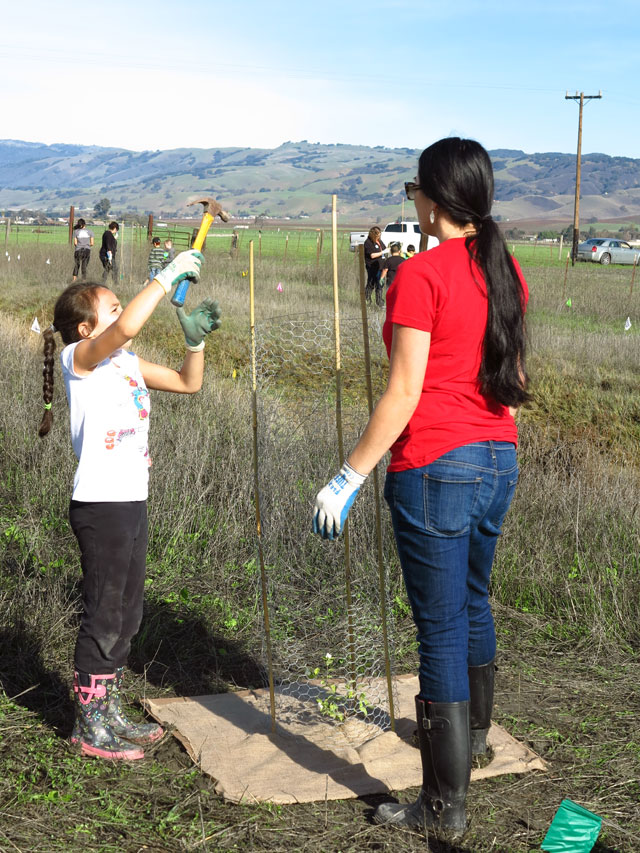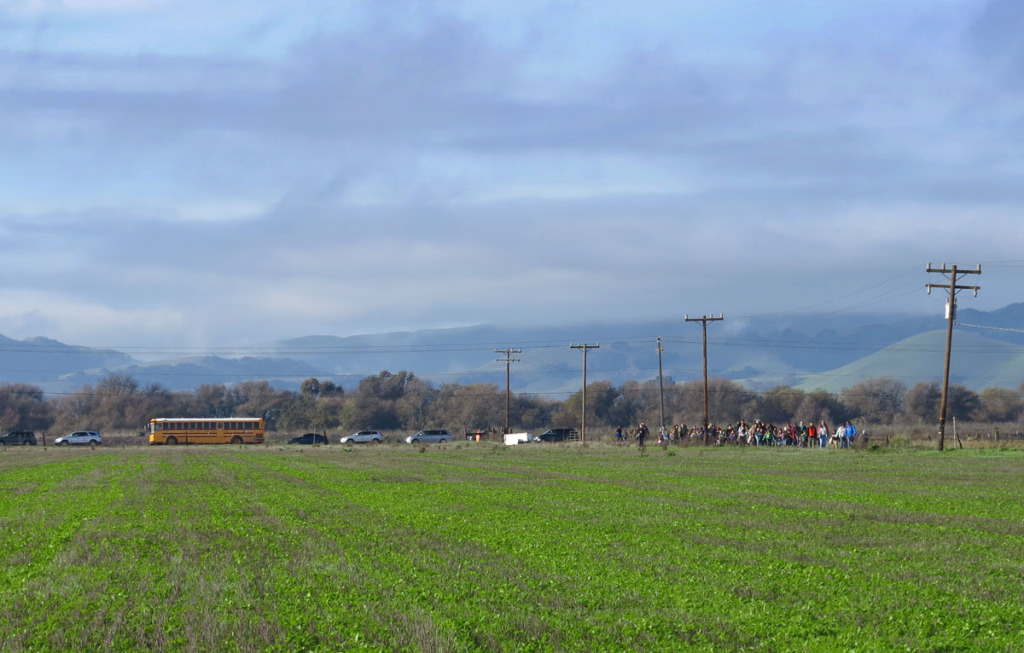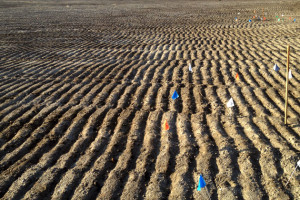he early morning fog was lifting from the Diablo and Santa Cruz mountain ranges as 65 second graders unloaded from a yellow school bus and walked across the exuberantly green floodplain of Gonzales Farm.
This flatland just outside of Gilroy stretches between the two coastal ranges, glowing green following the December rains like a glorious pastoral scene pulled from a picture book of California agriculture. Yet next to a grazing field an 8-foot wide channel, the only sign of the Pajaro River, suggested the contemporary changes cultivation has brought to the landscape. This land, once dominated by expanses of perennial freshwater wetland and seasonal wet meadow, was reclaimed in the 1870s and has been in use for agriculture ever since.
Restoring some semblance of habitat, while preserving the pastoral use and feel, is the goal of The Nature Conservancy (TNC), which own the property and leases the land to a local rancher.
Enter those kids. Students from a school in nearby Watsonville, they’re part of Point Blue Conservation Science’s Students and Teachers Restoring a Watershed Program (STRAW). One plant at a time, STRAW’s young volunteers will restore a corridor for migrating animals along the Upper Pajaro River. This is STRAW’s first collaboration with TNC, but like other STRAW projects, it marries vision with implementation: an idea about landscape restoration and an idea about the way the people who live, work, and play on that land can – and should — be part of restoring it.
lex Gonzalez, the parent of one of the second grade volunteers, grew up in Watsonville and knows this stretch of the river well. “We used to collect hay from here,” he said, pointing towards the empty field in front of us and shrugging his shoulders. “There has been a lot of change. There used to be dairy farms, a slaughterhouse, and apple orchards. Now it’s residential. I’ve watched the apple orchards being taken out. It’s sad to see. It takes away memories.”
Along with increasing population, historically intensive farming and canal diversions have changed the Gonzales parcel. The Pajaro River used to flow through a channel here before being diverted into a canal built by early-20th century cattle tycoon Henry Miller to irrigate his ranchlands. Miller’s name, found on streets and parks in Gilroy today, is a reminder of the legacy of the town’s farm economy. Agriculture and ranching are an inextricable part of the identity of this land and community.
The Gonzales farm, of course, isn’t a natural landscape; it is a working one. But enough time has passed since its cultivation that wildlife has figured out how to survive on these lands and it’s a concern when they become threatened. The Nature Conservancy worries about degraded habitat along the river, development in the floodplain, loss of agricultural lands, and lack of pathways for wildlife to cross between mountain ranges that need room to find food and reproduce.
Gonzalez and his children, and his children’s friends, are the chance to reverse those declines and build a new narrative around the idea that restoring this channel as a habitat can have a positive impact for the land, animals, and community.

ext to the channel, the wriggling second-graders gathered in a circle after dropping their snack bags and backpacks in a big pile. The leaders from STRAW and TNC began outlining what was going to happen that day. “I’m hungry!” a little girl shouted as Laurette Rogers, the director of STRAW, asked, “Is everyone ready to listen?”
Sasha Gennet, an ecologist with TNC, explained to the students, “We’re trying to get animals from those hills over there,” pointing towards the Santa Cruz range, “to these hills,” turning the other direction towards the Hamilton Mountains in the west.
Gennet asked the students, “If you’re an animal, do you like walking across an open and hot place or a place with trees?”
“Trees!” the kids shouted back.
TNC purchased Gonzales Farm in October 2012, after 15 years working in the Mount Hamilton area. TNC identified the channel as the best corridor for migrating animals, engaged in the landscape-level perspective of the restoration project.
“We’re not trying to restore the land back to a historic idea, but provide more connectivity and function,” said Kirk Klausmeyer a conservation analyst with TNC.
For STRAW, providing this connectivity means getting the local community and their children involved. “It’s a big day for the kids,” Rogers said, “to do something that they know is contributing to their community. There is a lot of healing going on.”

n preparation for the restoration day, the students learned about the watershed in a classroom presentation. They talked about the animals that use the creek and how planting trees to restore their habitat could help them and the ranchlands. By the time they were out on the land, with shovels and plantings in sight, there was much excitement in the air and not much that the adults could say to keep their attention.
Still, it fell on Isaiah Thalmayer, a project manager from STRAW, to provide the students with a planting demonstration – match a plastic flag to a plant, please use the tools safely – before they set out onto the field for the day’s work.
At last, released from adult lectures, the young volunteers scattered along the channel with shovels, hammers, burlap, cardboard, wire, bamboo sticks, and plants (and their parents in tow). Now, the sun was fully shining, and the smell of sunscreen floated through the air.
Thalmayer said that the project will continue planting over the next three years, gesturing from one end of the channel to the other to demonstrate the 1.25-mile area they hope to cover with more than 30 species of trees and shrubs.
For the day though, the goal was for the kids to put plants into the ground, along lines on both sides of the channel, marked by those brightly colored flags. And for the kids to learn they could help fix this landscape by themselves.
“This shows how a professional quality restoration can be done by school kids,” Rogers said. She watched for a moment as the children picked up their shovels. “Imagine,” she said, “if everyone was doing this. We can do this everywhere.”
In between work, the kids found time to explore the channel. One boy yelled out, “I found a crawdad!” causing a hubbub as other kids clambered around him to take a look. Two girls took a break from digging to play patty-cake. “This is a meaningful field trip for the kids,” said Stephanie Barnes, the class’s teacher. “Some of the kids that would be considered problem students are the ones that do the best out here.”
TRAW evolved from a project started when Rogers was a fourth-grade teacher and had a student named John Elliot. One day, Elliott asked, “what can we do to help endangered species?” It was the beginning of “the Shrimp Project” in Rogers’ classroom, focused on saving one small critter: the endangered California freshwater shrimp. Rogers and her fourth graders worked with ranchers and professional restoration designers, planting native willows along Stemple Creek in West Marin to begin restoring the shrimp’s riparian habitat. After 22 years, STRAW has grown into a project-based environmental education organization, with 52 restoration projects in the North Bay and Gilroy this year alone.
STRAW has become the anchor for landscape-level restoration projects: the way for an international, billion-dollar conservation enterprise like The Nature Conservancy to align its own long-term vision for the land with the people it hopes will benefit from it.
Larry Serpa, an aquatic biologist with TNC, wandered down the channel with a white net in hand, looking for the small, hard to spot critters living there.
Holding up a plastic cube containing a brightly-colored red, wingless wasp, commonly known as a velvet ant, Serpa drew his own natural-history-inspired analogy on the importance of starting small: “The velvet ant has to move from the Santa Cruz range to the Hamilton Mountains, just like the big animals,” he said. “But, for them, it could take hundreds of years.”
Serpa worked with Rogers on the Shrimp Project, as did Stephanie Barnes, the second-graders’ teacher, who was a student-teacher with Rogers before the first shrimp habitat restoration grew into STRAW.

fter several hours of digging, hammering stakes into the ground, and a fair bit of running around, it was lunchtime and the end of the restoration day for the kids. Only a few plants remained in their plastic containers; the rest were in the ground, protected by a cylinder of wire.
Though the young, freshly planted bushes and trees looked vulnerable along the bare channel, it was a day for thinking big. A few years down the line, the hope is for the trees and bushes to be large enough to provide a place for the velvet ants, deer, mountain lions, and other animals to roam. It’s not hard to connect this to the adult’s hope for the kids as well. As the kids grow up, perhaps they will return to the experience they had at the ranch to plant their own ideas.
Like Alex Gonzalez, the local parent from Watsonville, who will be able to come back to the field where he once collected hay with his father, and see the trees that his son planted.



